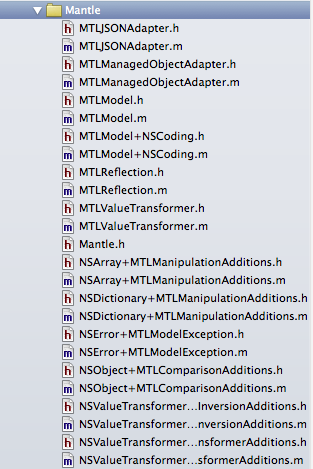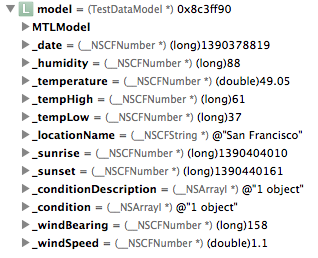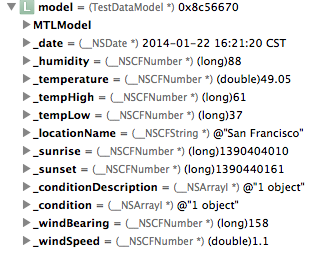我们常常会从网络获取数据,而数据通常又为JSON格式,JSON数据转为Model对象
2015-06-12 15:31
288 查看
Mantle 初步使用
JAN 22ND, 2014 | COMMENTS最近接触到了Mantle这个东西,感觉很不错,在此与各位分享一下。
前言
在开发的过程中,我们常常会从网络获取数据,而数据通常又为JSON格式。 这时比较常见的做法是把JSON数据转为Model对象,这样我们可以从Model对象的属性读取数据。 但是常常会面临如下一些问题:每次都要用
-initWithDictionarty:(NSDictionary *)dict等类似的方法初始化,把JSON数据里的值一个一个的赋值给Modeld对象的属性,深深的感觉到自己在做重复的工作,有木有!
当你需要的某个数据在JSON字典数据里层次很深时,需要不断的使用
[[obj objectForKey:@"key"] objectAtIndex:index] objectForKey:@""]...这样很长的代码,是不是感觉很不爽!
服务器给你返回的数据不是你期望的,例如:有些时候你需要的是一个NSString类型,但给你的是一个NSNumber。 有时你需要的是一个NSDate类型,但给你的是一个NSString类型,你还不得不去做一些判断,写一些转换的代码。 还有一种严重的情况,由于服务器故障,给你返回了一个NSNull,如果你没有做一些判断处理,那么这时你的程序崩溃的几率很大!
如何从这个Model对象,再还原成之前的JSON字典数据? 其次,你想把这个Model对象存储下来的话,那么你不得不自己去处理NSCoding协议等一些烦人的问题,又是一些重复工作!
有没有办法可以很优雅的解决这些问题呢,这就是今天要说的Mantle框架。
什么是Mantle?
Mantle是github的工程师们弄出来的东西,github主页在此, 引用如下:Mantle makes it easy to write a simple model layer for your Cocoa or Cocoa Touch application.
使用
下面就来说一下怎么使用,首先新建一个空的工程,把Mantle的代码下载下来,拖入你的工程。 我建议使用CocoaPods来管理第三方库,反正我就是这样干的,非常简单方便。 浏览一下框架的目录,大概如下图所示:
居然这么多文件! 不要害怕,我们常用到的就是
MTLJSONAdapter和
MTLModle而已。
MTLModel是一个抽象类,它帮我们做了很多工作,比如解决前言里提出的一些问题。
我们要建的Model类应该继承于它,此外你的继承类一定还要实现
MTLJSONSerializing协议。
MTLJSONAdapter则是帮我们把JSON数据绑定到Model的属性里,当然,你不用担心会出现
NSNull的情况,因为转换后它会自动设置成
nil;
我们新建一个继承
MTLModel的类,叫做
TestDataModel。
我们将从这个地址获取测试数据。 现在把想要的数据声明到头文件里
1 2 3 4 5 6 7 8 9 10 11 12 13 14 15 16 17 18 19 | //TestDataModel.h #import <Mantle/Mantle.h> @interface TestDataModel : MTLModel<MTLJSONSerializing> @property (nonatomic, strong) NSDate *date; @property (nonatomic, strong) NSNumber *humidity; @property (nonatomic, strong) NSNumber *temperature; @property (nonatomic, strong) NSNumber *tempHigh; @property (nonatomic, strong) NSNumber *tempLow; @property (nonatomic, strong) NSString *locationName; @property (nonatomic, strong) NSDate *sunrise; @property (nonatomic, strong) NSDate *sunset; @property (nonatomic, strong) NSString *conditionDescription; @property (nonatomic, strong) NSString *condition; @property (nonatomic, strong) NSNumber *windBearing; @property (nonatomic, strong) NSNumber *windSpeed; @end |
TestDataModel.m文件里,实现
MTLJSONSerializing协议里的
+ (NSDictionary *)JSONKeyPathsByPropertyKey方法。
1 2 3 4 5 6 7 8 9 10 11 12 13 14 15 16 17 18 1920 | //TestDataModel.m
#import "TestDataModel.h"
@implementation TestDataModel
+ (NSDictionary *)JSONKeyPathsByPropertyKey {
return @{
@"date": @"dt", //将JSON字典里dt键对应的值,赋值给date属性
@"locationName": @"name",
@"humidity": @"main.humidity",
@"temperature": @"main.temp",//这个点是什么意思呢,表示将main键对应的子字典里,
//temp键对应的值赋给temperature属性。
//我们不用再写 objectForKey]objectForKey]..这种代码了。
//注意了:当main键对应的是数组时,main.temp返回的
//为所有temp键对应值的数组合集
@"tempHigh": @"main.temp_max",
@"tempLow": @"main.temp_min",
@"sunrise": @"sys.sunrise",
@"sunset": @"sys.sunset",
@"conditionDescription": @"weather.description",
@"condition": @"weather.main",
@"icon": @"weather.icon",
@"windBearing": @"wind.deg",
@"windSpeed": @"wind.speed",
};
} |
AppDelegate.m里,编写相关的测试代码
1 2 3 4 5 6 7 8 9 10 11 12 13 14 15 16 17 18 19 | - (BOOL)application:(UIApplication *)application didFinishLaunchingWithOptions:(NSDictionary *)launchOptions
{
NSURL *url = [NSURL URLWithString:@"http://api.openweathermap.org/data/2.5/weather?lat=37.785834&lon=-122.406417&units=imperial"];
[NSURLConnection sendAsynchronousRequest:[NSURLRequest requestWithURL:url]
queue:[NSOperationQueue mainQueue]
completionHandler:^(NSURLResponse* response, NSData* data, NSError* connectionError){
if (!connectionError) {
NSDictionary *dict = [NSJSONSerialization JSONObjectWithData:data
options:NSJSONReadingMutableContainers
error:nil];
//将JSON数据和Model的属性进行绑定
TestDataModel *model = [MTLJSONAdapter modelOfClass:[TestDataModel class]
fromJSONDictionary:dict
error:nil];
NSLog(@"%@",model);
}
}];
} |

可以看到所有属性值均已设置好了。 强大吧! 等等…这好像和我们期望的类型不太一样,我们声明的date是一个NSDate型,但这里却是NSNumber。JSON数据里解析出来的就是NSNumber,那要怎么转化为我们期望的NSDate呢? Mantle为我们提供了强大的转换机制。 继续回到
TestDataModel.m文件里。添加如下代码:
1 2 3 4 5 6 7 8 9 | //TestDataModel.m
+ (NSValueTransformer *)dateJSONTransformer {
return [MTLValueTransformer reversibleTransformerWithForwardBlock:^(NSNumber *dateNum) {
return [NSDate dateWithTimeIntervalSince1970:dateNum.floatValue];
} reverseBlock:^(NSDate *date) {
return [NSString stringWithFormat:@"%f",[date timeIntervalSince1970]];
}];
} |

看见了吗,date已经成功转换为NSDate了! 原来,上面的代码是要告知Mantle,赋值时要先进行转换,原始JSON里是一个NSNumber,现在转换为一个NSDate并返回。 其他属性需要转换的都可以这样做,方法命名规则是
属性JSONTransformer,那么在对这个属性进行赋值时就会调用这个方法先进行转换。当JSON数据里有NSNull的类型时,我们不用做任何处理,会自动将该属性置为nil;
那reverseBlock是干什么的呢? 当要把Model转换回JSON数据时,如果设置了返回值,那么会将NSDate转回NSNumber返回JSON数据。 我们可以调用
MTLJSONAdapter的
1 | + (NSDictionary *)JSONDictionaryFromModel:(MTLModel<MTLJSONSerializing> *)model; |
Model对象的存储:
由于MTLModel已经帮我们实现了NSCoding协议, 要把一个Model对象存储到本地就相当简单了,只需一行代码:1 | [NSKeyedArchiver archiveRootObject:model toFile:path]; |
1 | TestDataModel *unachiveModel = [NSKeyedUnarchiver unarchiveObjectWithFile:path]; |
原理
没有深入研究源码,准备抽时间仔细研究一把。 大致看了下,Mantle主要使用了一些Runtime的东西,获取到所有propertiy属性进行绑定。 代码看起来有种不明觉厉的感觉,不得不感叹github上的牛人真多! 想深入研究的同学可以多看下源码!
参考文章
https://github.com/MantleFramework/MantlePosted by ourui Jan
22nd, 2014 IOS
原创文章,版权声明:自由转载-非商用-非衍生-保持署名 | Creative Commons BY-NC-ND 3.0
相关文章推荐
- HTTP常见状态码
- linux 下网络流量监控
- 无线路由器桥接、中继、电力猫组网方法分享
- 网络编程基础:1
- Java课程实验报告 实验四 Java网络编程及安全
- 本地连接和无线网络连接控制
- OC—网络监控 使用Reachability
- Socket套接字通信原理
- HTTP请求头
- TCP/IP TIME_WAIT状态原理
- 在.NET4.5项目中添加HttpClient引用的办法
- Java 代码实现Http 的GET和POST 请求
- 网络流 dinic算法 记录
- 安卓手机抓包学习笔记-tcpdump
- Android/java 利用HttpUrlConnection 发送put请求,携带json参数
- 图解TCP-IP协议
- Android网络编程之传递数据给服务器
- Oralce网络配置解决本地访问服务器oracle
- Linux网络配置
- php开发环境(图文) 原地址:http://my.oschina.net/joanfen/blog?catalog=350189
